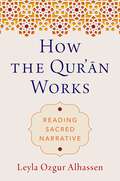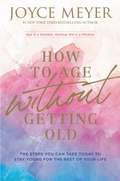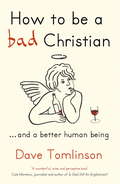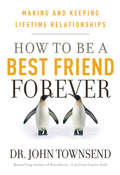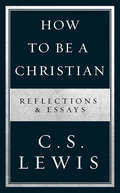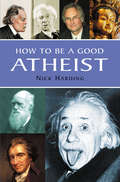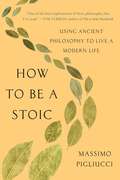- Table View
- List View
How the Bible Actually Works: In which I Explain how an Ancient, Ambiguous, and Diverse Book Leads us to Wisdom rather than Answers - and why that’s Great News
by Peter Enns'Seldom will you encounter such a fine combination of historical scholarship, interesting reading, and clever humour in one Biblical study. And then filled with faith and hope besides! Peter Enns does it again!' Richard Rohr, author of Falling UpwardFor many Christians, the Bible is a how-to manual filled with literal truths about belief that must be strictly followed. But the Bible is not an instruction manual or rule book but a powerful learning tool that nurtures our spiritual growth, argues Bible scholar Peter Enns. It does not hold easy answers to the perplexing questions and issues that confront us in our daily lives. Rather, the Bible is a dynamic instrument for study that not only offers an abundance of insights but provokes us to find our own answers to spiritual questions, cultivating God's wisdom within us. 'The Bible becomes a confusing mess when we expect it to function as a rulebook for faith. But when we allow the Bible to determine our expectations, we see that Wisdom, not answers, is the Bible's true subject matter', writes Enns. This distinction, he points out, is important because when we come to the Bible expecting it to be a textbook intended by God to give us unwavering certainty about our faith, we are actually creating problems for ourselves. The Bible, in other words, really isn't the problem; having the wrong expectation is what interferes with our reading.Rather than considering the Bible as an ancient book weighed down with problems, flaws, and contradictions that must be defended by modern readers, Enns offers a vision of the holy scriptures as an inspired and empowering resource to help us better understand how to live as a person of faith today. How the Bible Actually Works makes clear that there is no one right way to read the Bible. Moving us beyond the damaging idea that 'being right' is the most important measure of faith, Enns's freeing approach to Bible study helps us to instead focus on pursuing enlightenment and building our relationship with God - which is exactly what the Bible was designed to do.
How the Bible Became Holy
by Michael L SatlowIn this sweeping narrative, Michael Satlow tells the fascinating story of how an ancient collection of obscure Israelite writings became the founding texts of both Judaism and Christianity, considered holy by followers of each faith. Drawing on cutting-edge historical and archeological research, he traces the story of how, when, and why Jews and Christians gradually granted authority to texts that had long lay dormant in a dusty temple archive. The Bible, Satlow maintains, was not the consecrated book it is now until quite late in its history.He describes how elite scribes in the eighth and seventh centuries B.C.E. began the process that led to the creation of several of our biblical texts. It was not until these were translated into Greek in Egypt in the second century B.C.E., however, that some Jews began to see them as culturally authoritative, comparable to Homer’s works in contemporary Greek society. Then, in the first century B.C.E. in Israel, political machinations resulted in the Sadducees assigning legal power to the writings. We see how the world Jesus was born into was largely biblically illiterate and how he knew very little about the texts upon which his apostles would base his spiritual leadership.Synthesizing an enormous body of scholarly work, Satlow’s groundbreaking study offers provocative new assertions about commonly accepted interpretations of biblical history as well as a unique window into how two of the world’s great faiths came into being.
How the English Reformation was Named: The Politics of History, 1400-1700
by Benjamin M. GuyerHow the English Reformation was Named analyses the shifting semantics of 'reformation' in England between the fifteenth and seventeenth centuries. Originally denoting the intended aim of church councils, 'reformation' was subsequently redefined to denote violent revolt, and ultimately a series of past episodes in religious history. But despite referring to sixteenth-century religious change, the proper noun 'English Reformation' entered the historical lexicon only during the British civil wars of the 1640s. Anglican apologists coined this term to defend the Church of England against proponents of the Scottish Reformation, an event that contemporaries singled out for its violence and illegality. Using their neologism to denote select events from the mid-Tudor era, Anglicans crafted a historical narrative that enabled them to present a pristine vision of the English past, one that endeavoured to preserve amidst civil war, regicide, and political oppression. With the restoration of the monarchy and the Church of England in 1660, apologetic narrative became historiographical habit and, eventually, historical certainty.
How the English Reformation was Named: The Politics of History, 1400-1700
by Benjamin M. GuyerHow the English Reformation was Named analyses the shifting semantics of 'reformation' in England between the fifteenth and seventeenth centuries. Originally denoting the intended aim of church councils, 'reformation' was subsequently redefined to denote violent revolt, and ultimately a series of past episodes in religious history. But despite referring to sixteenth-century religious change, the proper noun 'English Reformation' entered the historical lexicon only during the British civil wars of the 1640s. Anglican apologists coined this term to defend the Church of England against proponents of the Scottish Reformation, an event that contemporaries singled out for its violence and illegality. Using their neologism to denote select events from the mid-Tudor era, Anglicans crafted a historical narrative that enabled them to present a pristine vision of the English past, one that endeavoured to preserve amidst civil war, regicide, and political oppression. With the restoration of the monarchy and the Church of England in 1660, apologetic narrative became historiographical habit and, eventually, historical certainty.
How the Gospels Became History: Jesus and Mediterranean Myths (Synkrisis)
by M. David LitwaA compelling comparison of the gospels and Greco-Roman mythology which shows that the gospels were not perceived as myths, but as historical records Did the early Christians believe their myths? Like most ancient—and modern—people, early Christians made efforts to present their myths in the most believable ways. In this eye-opening work, M. David Litwa explores how and why what later became the four canonical gospels take on a historical cast that remains vitally important for many Christians today. Offering an in-depth comparison with other Greco-Roman stories that have been shaped to seem like history, Litwa shows how the evangelists responded to the pressures of Greco-Roman literary culture by using well-known historiographical tropes such as the mention of famous rulers and kings, geographical notices, the introduction of eyewitnesses, vivid presentation, alternative reports, and so on. In this way, the evangelists deliberately shaped myths about Jesus into historical discourse to maximize their believability for ancient audiences.
How the Holocaust Looks Now: International Perspectives
by M. Davies C. SzejnmannThis collection offers a series of essays that explore the historical culture the holocaust has engendered in Europe, Israel and the USA, the politics of its reception and representation, the motivations for and effectiveness of commemorating it, and the creative and didactic practices it has generated in contemporary literature, art, and thought.
How the Light Gets In: Ethical Life I
by Graham WardHow the Light Gets In: Ethical Life I presents a systematic account of the teachings of the Christian faith to offer a vision, from a human, created, and limited perspective, of the ways all things might be understood from the divine perspective. It explores how Christian doctrine is lived, and the way in which beliefs are not simply cognitive sets of ideas but embodied cultural practices. Christians learn how to understand the contents of their faith, learn the language of the faith, through engagements that are simultaneously somatic, affective, imaginative, and intellectual. In the first of four volumes, Graham Ward examines the complex levels of these engagements through three historical developments in the systematic organization of doctrine: the Creeds, the Summa, and Protestant dogmatics. He outlines a methodology for exploring and practicing systematic theology that captures how the faith is lived in cultural, social, and embodied engagements. Ward then unpicks several fundamental theological concepts and how they are to be understood from the point of view of an engaged systematics: truth, revelation, judgement, discernment, proclamation, faith seeking understanding, and believing as it relates to and grounds the possibilities for faith. This groundbreaking work offers an interdisciplinary investigation through poetry, art, film, the Bible and theological discourse, analysing the human condition and theology as the deep dream for salvation. The final part relates theology as a lived and ongoing pedagogy concerned with individual and corporate formation to biological life, social life, and life in Christ. Here an approach to living theologically is sketched that is the primary focus for all four volumes: ethical life.
How the Qur'=an Works: Reading Sacred Narrative
by Leyla Ozgur AlhassenThe Qur'an is a text of extraordinary depth and complexity. In How the Qur'an Works, Leyla Ozgur Alhassen takes the reader on a journey through the Qur'an, moving from one verse to another, one story to another, focusing on narratological elements while conducting a close reading in order to understand particular Qur'anic stories and to show how the text's literary techniques enhance its theological agenda. She unpacks the text by focusing on Qur'anic narrative, and specifically, repetition in Qur'anic stories. Repetition is an important part of the Qur'an's literary technique. Ozgur Alhassen traces the use of repetition as a narrative device from the text's overall structure to individual letters. She compares different Qur'anic stories and explores the kinds of repetition that occur in them and what purposes they serve. Repetition, she shows, forges patterns, connections, and layers of meaning that develop, complicate, and comment on the Qur'an's messages.
How the Qur'=an Works: Reading Sacred Narrative
by Leyla Ozgur AlhassenThe Qur'an is a text of extraordinary depth and complexity. In How the Qur'an Works, Leyla Ozgur Alhassen takes the reader on a journey through the Qur'an, moving from one verse to another, one story to another, focusing on narratological elements while conducting a close reading in order to understand particular Qur'anic stories and to show how the text's literary techniques enhance its theological agenda. She unpacks the text by focusing on Qur'anic narrative, and specifically, repetition in Qur'anic stories. Repetition is an important part of the Qur'an's literary technique. Ozgur Alhassen traces the use of repetition as a narrative device from the text's overall structure to individual letters. She compares different Qur'anic stories and explores the kinds of repetition that occur in them and what purposes they serve. Repetition, she shows, forges patterns, connections, and layers of meaning that develop, complicate, and comment on the Qur'an's messages.
How the Spiritual World Projects into Physical Existence: The Influence of the Dead
by Rudolf SteinerThe founding of the Anthroposophical Society in 1913 marked a major change in Rudolf Steiner’s work. Although Steiner had always been an independent spiritual researcher, the break with the theosophists removed all constraints, allowing for a full flowering of anthroposophy. These lectures are filled with a freshness and vitality that reflect this new beginning, providing intriguing glimpses of great themes that Steiner was to develop in the years ahead.
How the West Became Antisemitic: Jews and the Formation of Europe, 800–1500
by Ivan G. MarcusAn examination of how the Jews—real and imagined—so challenged the Christian majority in medieval Europe that it became a society that was religiously and culturally antisemitic in new ways In medieval Europe, Jews were not passive victims of the Christian community, as is often assumed, but rather were startlingly assertive, forming a Jewish civilization within Latin Christian society. Both Jews and Christians considered themselves to be God&’s chosen people. These dueling claims fueled the rise of both cultures as they became rivals for supremacy. In How the West Became Antisemitic, Ivan Marcus shows how Christian and Jewish competition in medieval Europe laid the foundation for modern antisemitism.Marcus explains that Jews accepted Christians as misguided practitioners of their ancestral customs, but regarded Christianity as idolatry. Christians, on the other hand, looked at Jews themselves—not Judaism—as despised. They directed their hatred at a real and imagined Jew: theoretically subordinate, but sometimes assertive, an implacable &“enemy within.&” In their view, Jews were permanently and physically Jewish—impossible to convert to Christianity. Thus Christians came to hate Jews first for religious reasons, and eventually for racial ones. Even when Jews no longer lived among them, medieval Christians could not forget their former neighbors. Modern antisemitism, based on the imagined Jew as powerful and world dominating, is a transformation of this medieval hatred.A sweeping and well-documented history of the rivalry between Jewish and Christian civilizations during the making of Europe, How the West Became Antisemitic is an ambitious new interpretation of the medieval world and its impact on modernity.
How the West Became Antisemitic: Jews and the Formation of Europe, 800–1500
by Ivan G. MarcusAn examination of how the Jews—real and imagined—so challenged the Christian majority in medieval Europe that it became a society that was religiously and culturally antisemitic in new ways In medieval Europe, Jews were not passive victims of the Christian community, as is often assumed, but rather were startlingly assertive, forming a Jewish civilization within Latin Christian society. Both Jews and Christians considered themselves to be God&’s chosen people. These dueling claims fueled the rise of both cultures as they became rivals for supremacy. In How the West Became Antisemitic, Ivan Marcus shows how Christian and Jewish competition in medieval Europe laid the foundation for modern antisemitism.Marcus explains that Jews accepted Christians as misguided practitioners of their ancestral customs, but regarded Christianity as idolatry. Christians, on the other hand, looked at Jews themselves—not Judaism—as despised. They directed their hatred at a real and imagined Jew: theoretically subordinate, but sometimes assertive, an implacable &“enemy within.&” In their view, Jews were permanently and physically Jewish—impossible to convert to Christianity. Thus Christians came to hate Jews first for religious reasons, and eventually for racial ones. Even when Jews no longer lived among them, medieval Christians could not forget their former neighbors. Modern antisemitism, based on the imagined Jew as powerful and world dominating, is a transformation of this medieval hatred.A sweeping and well-documented history of the rivalry between Jewish and Christian civilizations during the making of Europe, How the West Became Antisemitic is an ambitious new interpretation of the medieval world and its impact on modernity.
How the Workers Became Muslims: Immigration, Culture, and Hegemonic Transformation in Europe
by Ferruh YilmazWriting in the beginning of the 1980s, Ernesto Laclau and Chantal Mouffe explored possibilities for a new socialist strategy to capitalize on the period’s fragmented political and social conditions. Two and a half decades later, Ferruh Yilmaz acknowledges that the populist Far Right—not the socialist movement—has demonstrated greater facility in adopting successful hegemonic strategies along new structural lines Laclau and Mouffe imagined. Right-wing hegemonic strategy, Yilmaz argues, has led to the reconfiguration of internal fault lines in European societies. Yilmaz’s primary case study is Danish immigration discourse, but his argument contextualizes his study in terms of questions of current concern across Europe, where right-wing groups that were long on the fringes of “legitimate” politics have managed to make significant gains with populations traditionally aligned with the Left. Specifically, Yilmaz argues that sociopolitical space has been transformed in the last three decades such that group classification has been destabilized to emphasize cultural rather than economic attributes. According to this point-of-view, traditional European social and political splits are jettisoned for new “cultural” alliances pulling the political spectrum to the right, against the “corrosive” presence of Muslim immigrants, whose own social and political variety is flattened into an illusion of alien sameness.
How Things Are: An Introduction to Buddhist Metaphysics (Buddhist Philosophy for Philosophers)
by Mark SideritsIt is widely known that Buddhists deny the existence of the self. However, Buddhist philosophers defend interesting positions on a variety of other issues in fundamental ontology. In particular, they have important things to say about ontological reduction and the nature of the causal relation. Amidst the prolonged debate over global anti-realism, Buddhist philosophers devised an innovative approach to the radical nominalist denial of all universals and real resemblances. While some defend presentism, others propound eternalism. In How Things Are, Mark Siderits presents the arguments that Buddhist philosophers developed on these and other issues. Those with an interest in metaphysics may find new and interesting insights into what the Buddhists had to say about their ideas. This work is designed to introduce some of the more important fruits of Buddhist metaphysical inquiry to philosophers with little or no prior knowledge of that tradition. While there is plenty of scholarship on the Indian Buddhist philosophical tradition, it is primarily concerned with the historical details, often presupposes background knowledge of the major schools and figures, and makes ample use of untranslated Sanskrit technical terms. What has been missing from this area of philosophical inquiry, are studies that make the Buddhist tradition accessible to philosophers who are interested in solving metaphysical problems. This work fills that gap by focusing not on history and texts but on the metaphysical puzzles themselves, and on ways of trying to solve them.
How Things Are: An Introduction to Buddhist Metaphysics (Buddhist Philosophy for Philosophers)
by Mark SideritsIt is widely known that Buddhists deny the existence of the self. However, Buddhist philosophers defend interesting positions on a variety of other issues in fundamental ontology. In particular, they have important things to say about ontological reduction and the nature of the causal relation. Amidst the prolonged debate over global anti-realism, Buddhist philosophers devised an innovative approach to the radical nominalist denial of all universals and real resemblances. While some defend presentism, others propound eternalism. In How Things Are, Mark Siderits presents the arguments that Buddhist philosophers developed on these and other issues. Those with an interest in metaphysics may find new and interesting insights into what the Buddhists had to say about their ideas. This work is designed to introduce some of the more important fruits of Buddhist metaphysical inquiry to philosophers with little or no prior knowledge of that tradition. While there is plenty of scholarship on the Indian Buddhist philosophical tradition, it is primarily concerned with the historical details, often presupposes background knowledge of the major schools and figures, and makes ample use of untranslated Sanskrit technical terms. What has been missing from this area of philosophical inquiry, are studies that make the Buddhist tradition accessible to philosophers who are interested in solving metaphysical problems. This work fills that gap by focusing not on history and texts but on the metaphysical puzzles themselves, and on ways of trying to solve them.
How Things Count as the Same: Memory, Mimesis, and Metaphor
by Adam B. Seligman Robert P. WellerIn their third book together, Adam B. Seligman and Robert P. Weller address a seemingly simple question: What counts as the same? Given the myriad differences that divide one individual from another, why do we recognize anyone as somehow sharing a common fate with us? For that matter, how do we live in harmony with groups who may not share the sense of a common fate? Such relationships lie at the heart of the problems of pluralism that increasingly face so much of the world today. Note that "counting as" the same differs from "being" the same. Counting as the same is not an empirical question about how much or how little one person shares with another or one event shares with a previous event. Nothing is actually the same. That is why, as humans, we construct sameness all the time. In the process, of course, we also construct difference. Creating sameness and difference leaves us with the perennial problem of how to live with difference instead of seeing it as a threat. How Things Count as the Same suggests that there are multiple ways in which we can count things as the same, and that each of them fosters different kinds of group dynamics and different sets of benefits and risks for the creation of plural societies. While there might be many ways to understand how people construct sameness, three stand out as especially important and form the focus of the book's analysis: Memory, Mimesis, and Metaphor.
How Things Count as the Same: Memory, Mimesis, and Metaphor
by Adam B. Seligman Robert P. WellerIn their third book together, Adam B. Seligman and Robert P. Weller address a seemingly simple question: What counts as the same? Given the myriad differences that divide one individual from another, why do we recognize anyone as somehow sharing a common fate with us? For that matter, how do we live in harmony with groups who may not share the sense of a common fate? Such relationships lie at the heart of the problems of pluralism that increasingly face so much of the world today. Note that "counting as" the same differs from "being" the same. Counting as the same is not an empirical question about how much or how little one person shares with another or one event shares with a previous event. Nothing is actually the same. That is why, as humans, we construct sameness all the time. In the process, of course, we also construct difference. Creating sameness and difference leaves us with the perennial problem of how to live with difference instead of seeing it as a threat. How Things Count as the Same suggests that there are multiple ways in which we can count things as the same, and that each of them fosters different kinds of group dynamics and different sets of benefits and risks for the creation of plural societies. While there might be many ways to understand how people construct sameness, three stand out as especially important and form the focus of the book's analysis: Memory, Mimesis, and Metaphor.
How to Age Without Getting Old: The Steps You Can Take Today to Stay Young for the Rest of Your Life
by Joyce MeyerBe empowered and equip yourself with tools to live a full and fruitful life at any age with renowned Bible teacher and #1 New York Times bestselling author Joyce Meyer.Everything is beautiful in its time. Life is a journey through beautiful and varied seasons, with a dynamic cadence and full of continued discovery. Embrace each season of your life and learn to live into it fully with grace and help from Joyce Meyer, as she shows you:- How to truly cast even your lifelong cares upon the Lord- How to live dynamically, embracing and delighting in the journey- How to embrace God's grace for this season- How to live abundantly as your body and mind changeGod's timing is always perfect, and there is a distinct and meaningful purpose for this season of your life. Joyce says, 'Only a fool thinks they can always do what they have always done.' How to Age Without Getting Old equips us to become wise enough to embrace God's changing grace and the evolution of our calling to the next season of life.
How to be a Bad Christian: ... And a better human being
by Dave TomlinsonIn the course of his work as a vicar, Dave Tomlinson meets lots of people who describe themselves as 'not good enough' to be a Christian, thinking that faith involves going to church a lot, or believing in a list of strange things, or following certain rules. But being a Christian isn't about any of that - and actually, following Jesus is a lot easier, and more fun, than most people think...In this handbook to Christianity for people who describe themselves as spiritual but not necessarily religious, Dave sketches out some key practices for how to be a 'bad' Christian, including how to talk to God without worrying about prayer, how to read the Bible without turning off your brain, and how to think with your soul rather than trying to follow rules. With beautiful illustrations from artist Rob Pepper, this is an accessible, light-hearted book, but one with a powerful invitation: to be the person you've always wanted to be, following a God you've always hoped is on your side.
How to be a Best Friend Forever: Making and Keeping Lifetime Relationships
by John TownsendThe quality of your friendships determines the quality of your life.
How to Be a Christian: Reflections And Essays
by C. S. LewisHow to Be a Christian brings together the best of Lewis’s insights on Christian practice and its expression in our daily lives. Cultivated from his many essays, articles, and letters, as well as his classic works.
How to be a Good Atheist
by Nick HardingJoin the fastest growing minority there is and become an atheist. Fed up of religion telling you it has all the answers when it doesn't? Tired of hearing about divine mysteries when there aren't any? Irritated by the pious evangelistas telling you you're going to hell when you're obviously not? Exhausted by creationists…for simply being creationists? Want to know more about the so-called atheist conspiracy? Then this book is for you. For millennia priests and holy men have told countless conflicting tales about humanity's genesis and fate. Is it all nonsense? You bet it is. For round about the same amount of time they have also been saying that anyone devoid of faith is evil, immoral and responsible for all of society's ills. How wrong they are. This book contains all you need to know about what to pack for your journey on the enlightening road to atheism including a brief history of free thought - it goes back further than you think - all the way to an introductory who's who in purgatory for knowing there isn't a god. Learn that there are five types of atheism. Find out the difference between an atheist and an agnostic - a term invented by T.H.Huxley, famous for his defence of Darwin and how a deist differs from a theist. Discover the oxymoronic fact that Christians were originally called atheists. Read who Lucretius was and what his fellow materialists were about. And revel in the fact that atheists have nothing to defend but are happy that way…
How to Be a Stoic: Using Ancient Philosophy to Live a Modern Life
by Massimo PigliucciIn the tradition of How to Live and How Proust Can Change Your Life, a philosopher asks how ancient Stoicism can help us flourish today Whenever we worry about what to eat, how to love, or simply how to be happy, we are worrying about how to lead a good life. No goal is more elusive. In How to Be a Stoic, philosopher Massimo Pigliucci offers Stoicism, the ancient philosophy that inspired the great emperor Marcus Aurelius, as the best way to attain it. Stoicism is a pragmatic philosophy that focuses our attention on what is possible and gives us perspective on what is unimportant. By understanding Stoicism, we can learn to answer crucial questions: Should we get married or divorced? How should we handle our money in a world nearly destroyed by a financial crisis? How can we survive great personal tragedy? Whoever we are, Stoicism has something for us--and How to Be a Stoic is the essential guide.
How To Be An Agnostic
by Mark VernonThe authentic spiritual quest is marked not by certainties but by questions and doubt. Mark Vernon who was a priest, and left an atheist explores the wonder of science, the ups and downs of being 'spiritual but not religious', the insights of ancient philosophy, and God the biggest question.
How to Be an Even Better Listener: A Practical Guide for Hospice and Palliative Care Volunteers
by Robert MundleProviding guidance and advice on the challenging art of listening, this book responds directly to the expressed learning needs of hospice and palliative care volunteers regarding their communication skills in end-of-life care.Listening can be mentally, physically, and spiritually exhausting, often highlighted in books about hospice and palliative care but never taking the spotlight. This accessible companion provides hospice and palliative care workers with a variety of helpful insights and suggestions drawn from a solid base of current theoretical concepts and clinical research.With personal reflections on being listened to, the guide includes strategies for becoming a more effective listener, as well as exploring the challenges of listening, the need for self-care and spiritual and ethical considerations. By expanding their own capacity for empathy, compassion and understanding the wider narrative of illness, hospice and palliative care volunteers will become even better listeners in their essential roles.






